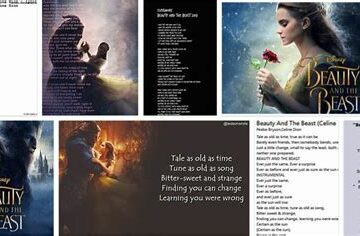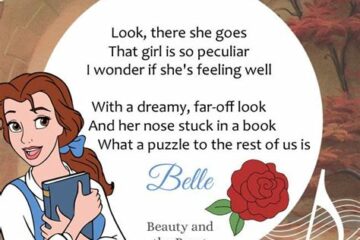Exploring The Mythology And Origins Of Beauty And The Beast

Exploring The Mythology And Origins Of Beauty And The Beast
Exploring The Cultural Myths Behind Beauty And The Beast
The enchanting tale of Beauty and the Beast has captivated audiences globally and transcends mere storytelling; it is deeply rooted in various cultural myths. Throughout history, different cultures have expressed their ideals of beauty through a myriad of narratives, foretelling the significance of inner versus outer beauty. The duality expressed in Beauty and the Beast serves as a reflection of these ancient beliefs.
In many mythologies, the juxtaposition of beauty and beastliness often highlights societal values. For instance, in ancient Greek mythology, stories like that of Eros and Psyche emphasize the importance of love, acceptance, and the idea that true beauty lies within. Similarly, “Beauty and the Beast” reiterates this concept, demonstrating that genuine love can emerge even from seemingly repulsive appearances.
Moreover, various cultural interpretations offer insights into the hero’s journey, often depicting transformative experiences that transcend superficial judgment. In numerous adaptations across cultures, this theme remains prominent: the beast’s outer appearance often symbolizes trials, challenges, or circumstances that have shaped the character’s essence. This narrative structure exemplifies a recurring mythic tradition that emphasizes personal growth through adversity.
Additionally, the concept of beauty itself varies across cultures, shaping the contexts in which the tale is told. In some societies, beauty is associated with specific traits, such as virtue or purity, embodying a moralistic undertone. The character of Belle, for example, reflects an appreciation for wisdom, bravery, and compassion, values that dominate many cultural benchmarks of beauty.
Thus, by exploring the cultural myths attached to Beauty and the Beast, we gain a broader understanding of how beauty is perceived across different societies and periods. It becomes evident that the tale is not merely about romance but also serves as a lens through which we can examine our collective human experiences, values, and ideals concerning beauty.
Origins Of The Beauty And The Beast Tale Through History
The tale of Beauty and the Beast has captivated audiences for centuries, weaving its way through various cultures and epochs. This fascinating story, which has been retold in countless forms—from classic literature to modern film adaptations—finds its roots in diverse folktales and narratives throughout history.
The earliest renditions of this story can be traced back to ancient civilizations. One of the most notable examples comes from Greece, in the myth of Eros and Psyche. This tale explores the themes of love and sacrifice, showing that true beauty transcends mere physical appearance, a concept that resonates with the core of Exploring The Beauty and the Beast narrative.
In the 17th century, French novelist Gabrielle-Suzanne Barbot de Villeneuve published one of the first known literary versions of Beauty and the Beast. Her story introduced many elements we recognize today, such as the essential dynamic between the beautiful young woman and her monstrous captor. Villeneuve’s version contained deeper psychological and moral implications, emphasizing inner beauty and personal growth.
Later, in 1756, Jeanne-Marie Leprince de Beaumont simplified and condensed Villeneuve’s tale in her version, making it more accessible to a broader audience. This adaptation focused on the educational aspects of virtue and social values, effectively shaping the story into a moral lesson that would influence generations to come.
Across different cultures, variations of Beauty and the Beast exist. From the Persian story of *The Enchanted Horse* to the Chinese version featuring a tale of sacrifice and loyalty, the tale resonates with universal themes of love, redemption, and transformation. Each adaptation offers a unique lens through which the themes of the tale are examined, but the core message remains consistent: the importance of inner beauty and acceptance.
As society evolved, so too did the interpretations of Beauty and the Beast. The themes within the story reflect sociocultural changes, highlighting shifting ideals of beauty, relationships, and morality. The 1991 Disney animated adaptation is one of the most recognizable versions today, merging romance with a strong feminist perspective, thus catering to contemporary sensibilities while retaining the essential elements of the traditional tale.
The Exploring The origins of the Beauty and the Beast tale reveals a rich tapestry of cultural influences. This timeless narrative continues to speak to audiences worldwide, reinforcing the idea that true beauty lies within, and paving the way for endless adaptations and interpretations in the world of storytelling.
The Symbolism Of Beauty In Fairy Tales: A Deeper Look
The concept of beauty in fairy tales often transcends mere aesthetics, serving as a powerful symbol that conveys deeper meanings and moral lessons. In the context of Exploring The myth of Beauty and the Beast, beauty embodies more than just physical appearance; it intertwines with themes of love, sacrifice, and transformation.
At its core, beauty in fairy tales is frequently depicted as a reflection of virtue and goodness. Characters labeled as beautiful are often portrayed as kind-hearted and worthy of love, while their less attractive counterparts may embody negative traits. This dichotomy prompts readers and audiences to question societal norms regarding beauty and the value placed upon it, paving the way for an exploration of inner versus outer beauty.
The tale of Beauty and the Beast challenges conventional ideals of attractiveness by illustrating that true beauty lies within. The Beast, despite his fearsome appearance, possesses a noble heart, which is ultimately revealed through his actions and love for Belle. This narrative thread encourages audiences to look beyond superficial qualities and recognize the intrinsic value of compassion, kindness, and selflessness.
Moreover, the portrayal of beauty in fairy tales speaks to the idea of transformation. Characters often undergo significant changes—both in their appearance and character arc—through acts of kindness or the ability to love unconditionally. For instance, Belle’s love helps the Beast reclaim his humanity, symbolizing how love can metamorphose not just individuals but their perceptions of beauty itself.
In addition, the theme of beauty can also be linked to societal ideals and cultural expectations. Fairy tales often reflect the standards of their time, serving as a lens through which we can examine changing attitudes toward appearance, gender roles, and relationships. As society evolves, so too do the interpretations of what constitutes beauty, offering new insights into the narratives we create for ourselves.
The symbolism of beauty in fairy tales, particularly within the context of Exploring The myth of Beauty and the Beast, acts as a catalyst for personal growth, challenging audiences to reconsider the nature of beauty and its significance in human relationships. Through these timeless tales, we are reminded that true beauty comes from within, encouraging a journey of self-discovery and acceptance.
Exploring The Evolution Of Beauty And The Beast Adaptations
The tale of Beauty and the Beast has undergone numerous transformations since its inception, reflecting the changing values and expectations of society. Today, we will explore the key adaptations that have shaped this beloved story while highlighting how it resonates with contemporary audiences.
From the original French version penned by Gabrielle-Suzanne Barbot de Villeneuve in the 18th century to Jeane-Marie Leprince de Beaumont’s simplified retelling, the core narrative has always revolved around themes of love and redemption. Beaumont’s adaptation is perhaps the most famous due to its wide availability and appeal, especially in the context of children’s literature.
As we move into the 20th century, the story found new life in animated and live-action forms. Disney’s animated classic released in 1991 redefined the narrative for a modern audience. With memorable songs and sophisticated animation, it generated mass appeal and solidified the fairy tale’s status in pop culture. This adaptation emphasized the theme of inner beauty by deepening the relationship between Belle and the Beast, allowing viewers to connect emotionally with both characters.
In subsequent years, a slew of adaptations emerged across various media, including Broadway musicals, live-action films, and even contemporary retellings with a twist. Each version serves to highlight different aspects of the story’s morals and ethical dilemmas. For instance, the 2017 live-action film with Emma Watson as Belle expanded on gender roles and personal agency, reflecting a shift towards more empowered female protagonists.
Moreover, adaptations have also continued to explore the complexity of the Beast’s character. They delve deeper into his backstory, showcasing his struggles and character development, which adds more layers to the narrative. This evolution allows for discussions around themes such as empathy, transformation, and the capacity for change, making the story relevant for new generations.
exploring the various adaptations of Beauty and the Beast reveals a rich tapestry of cultural significance and artistic expression. Each iteration not only tells a captivating story but also speaks to the societal shifts that continue to resonate with audiences, reaffirming the timeless nature of this fairy tale classic.
Unraveling The Psychological Themes In Beauty And The Beast
The tale of Beauty and the Beast is not just a captivating story of love and transformation; it also delves deep into the psychological realms of human nature and relationships. By examining the characters of Beauty and the Beast, we uncover various themes that resonate with our own lives.
One of the most significant psychological themes in Beauty and the Beast is the concept of exploring the duality of human nature. The Beast, for instance, represents the struggle between our primal instincts and the capacity for love and compassion. Initially perceived as monstrous and terrifying, his character evolves as the story unfolds, highlighting the idea that beneath our external façades lie complexities that define our true selves.
Another key theme is the idea of inner beauty versus outer beauty. Beauty, or Belle, is drawn to the Beast not by his physical appearance but by his vulnerability and emotional depth. This pivotal relationship demonstrates the human tendency to seek substance over superficiality, encouraging audiences to reflect on their own biases regarding attractiveness.
Additionally, the theme of transformation plays a crucial role. The evolution of both characters throughout the story is a representation of personal growth and the power of love as a catalyst for change. This not only reflects the psychological journey of overcoming one’s fears and prejudices but also emphasizes the importance of self-acceptance and redemption in the path to happiness.
The psychological themes intertwined within Beauty and the Beast serve as a mirror to our inner lives, prompting us to confront our biases and illuminate the nature of true connection. The tale continues to resonate with audiences, reminding us of the transformative power of love in overcoming our deepest insecurities and fears.
Top 10 Disney Characters You Didn’t Know About
December 30, 2024A Deep Dive Into Disney Princesses And Their Stories
December 29, 2024The Meaning Behind Beauty And Beast Lyrics
December 29, 2024Why Beauty And The Beast Is A Timeless Disney Classic
December 29, 2024The Role Of Disney Princesses In Modern Culture
December 29, 2024Exploring The Themes In Beauty And The Beast Lyrics
December 28, 2024
Leave a reply Cancel reply
Recommended
-
The Use Of Color In Conveying Emotion In Beauty And The Beast
December 6, 2024 -
Lyrics to Evermore Beauty and the Beast by Michael Jackson
November 16, 2021 -
The Beauty and the Beast Prologue Lyrics
October 2, 2021









